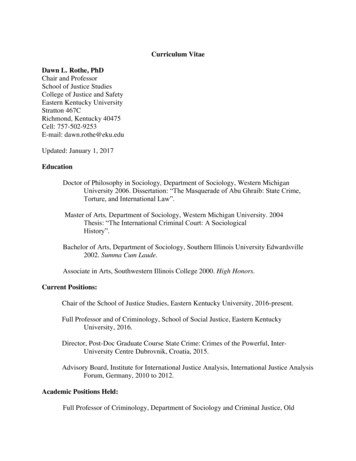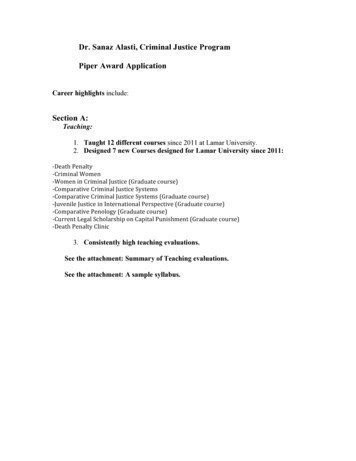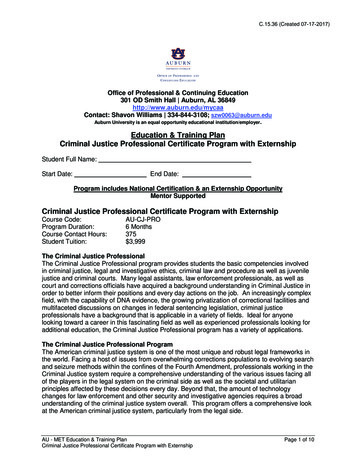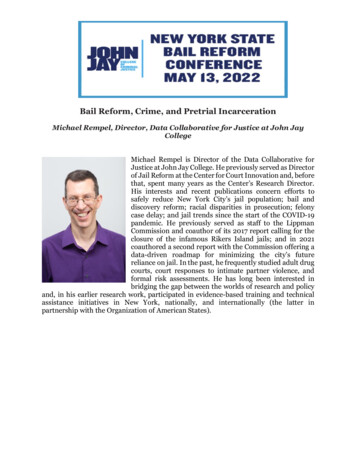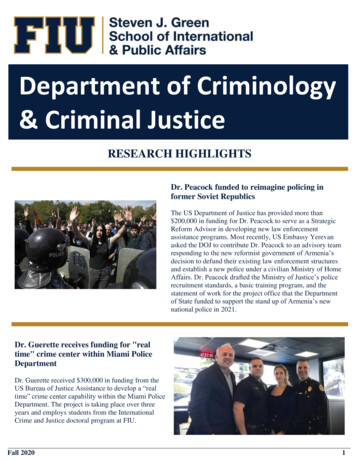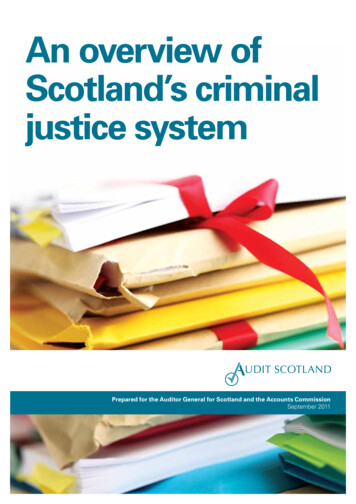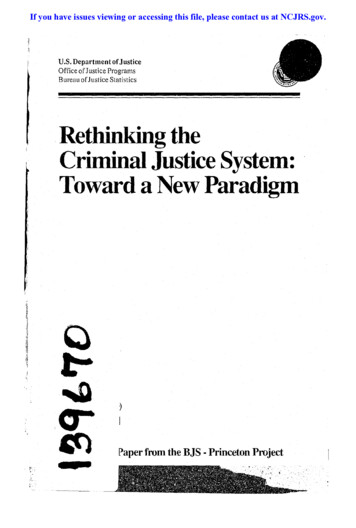
Transcription
If you have issues viewing or accessing this file, please contact us at NCJRS.gov.U.S. Depa rtment of JusticeOffice of J lIstice ProgramsBureau of Justice StatisticsRethinking theCriminal Justice System:Toward a New Paradigm'. I,1Paper from the BJS - Princeton Project
139670U.S. Department of JusticeNational Institute of JusticeThis document has been reproduced exactly as received from theperson or organization originating it. Points of view or opinions stated inthis document are those of the authors and do not necessarily representthe official position or policies of the NationallOlstitute of Justice.Permission to reproduce this copyrighted material has beengranted by. ]b1jcDamain/OJP/BJSu. S. Department of Justiceto the National Criminal Justice Reference Service (NCJRS).,Further reproduction outside of the NCJRS system requires permissionof the copyright owner.I.IRethinking theCriminal JusticeSystem: Towarda New ParadigmProfessor John J. Dilullo, JcPrinceton UniversityDecember 1992, NCJ·139670
U.S. Department of JusticeOffice of Justice ProgramsBureau of Justice StatisticsSteven D. Dillingham, Ph.D., LL.M.DirectorThis project is supported by BJS grant number92-BJ-CX-0002 to Princeton University. Thecontents of this document do not necessarilyreflect the views or policies of the Bureauof Justice Statistics or the U.S. Departmentof Justice.The Bureau of Justice Statistics, an agency of the U.S.Department of Justice, is part of the Office of JusticePrograms, which also includes the Bureau of JusticeAssistance, the National mstitute of Justice, the Officeof Juvenile Justice and Delinquency Prevention, andthe Office for Victims of Crime.ii Rethinking the Criminal Justice System
ForewordThis is the first paper in a series prepared by the BJSPrinceton University Study Group, under the direction ofProfessor John J. Dilulio, Jr. We established the StudyGroup to re-examine both the concepts and the methodologies involved in conceptualizing, measuring, and evaluating the performance of those agencies and actorscomprising the American criminal justice system.In this paper, Dr. Dilulio describes the need for operationalgoals, objectives, and performance measures to replace orsupplement the traditional criteria applied to controllingcrime and reducing recidivism. The paper summarizes thepurposes of a new paradigm aimed at enhancing ourgeneral understanding of the workings of the justice systemand appealing "for new concepts and categories ofthinking." By sketching the framework of Americanattitudes toward criminal justice and calling upon theAmerican public to assume a more meaningful role incrime prevention and control, the author lays a foundationfor more specific objectives and measures to come. Thoseobjectives and measures will derive from the four civicideals identified for criminal justice practices.BJS looks forward to future discussion papers from theBJS-Princeton Study Group as the series fulfills itsvaluable mission of suggesting new analyses and ideasrelated to understanding and evaluating the performanceof the justice system. Ultimately, this endeavor will asssistpractitioners and researchers in discovering new operational uses of future research findings and statistical analyses.Steven D. Dillingham, Ph.D., LL.M.Director, Bureau of Justice StatisticsRethinking the Criminal Justice System iii
Members of the BJS . Princeton Project Geoffrey P. Alpert, University of South Carolina Norman A. Carlson, University of Minnesota John J. Dilulio, Jr. (project director),Princeton University Steven D. Dillingham, Director, BJS Wayne Estelle, former warden, California Men's Colony Charles H. Logan, University of Connecticut Mark H. Moore, Harvard University Joan R. Petersilia, RAND Corporation James Short, Washington State University James Q. Wilson (project advisor),University of California at Los AngelesAbout the authorJohn J. Dilulio, Jr., is Professor of Politics and PublicAffairs at Princeton University and nonresident SeniorFellow in Governmental Studies at the BrookingsInstitution. He served as founding director of Princeton'sCenter of Domestic a.'1d Comparative Policy Studies.He is a member of the National Commission on Stateand Local Public Service.iv Rethinking the Criminal Justice System"
t;Rethinking the Criminal JusticeSystem: Toward a New ParadigmI. Overview: Beyond crime rates andrecidivism ratesRates of crime and recidivism have long served as criticalmeasures for the performance of the Nation's criminaljustice system. These measures represent the basic goalsof public safety to which all components of the criminaljustice system contribute. At the same time, however, ratesof crime and recidivism are not the only, or necessarily thebest, measures of what criminal justice institutions do.Few police officers believe that their work solely determines crime rates in their jurisdiction. Few correctionsofficials believe that what they do chiefly determinesrecidivism rates. Likewise, most criminal court judges,prosecutors, public defenders, and other justice practitioners know from experience that the prevalence andseverity of crime depend mainly on factors affectingRethinking the Criminal Justice System 1
individuals long before most are taken into custody. Mostjustice practitioners understand they can rarely do for theirclients what parents, teachers, friends, neighbors, clergy,bio-genetic inheritances, or economic opportunities mayhave failed to do. 1Still, crime rates and recidivism rates are meaningfuloverall measu.res of the system's performance in protectingpublic safety, and what justice practitioners do undoubtedlyaffects crime and recidivism rates. For example, a NationalAcademy of Sciences panel concluded that rising imprisonment rates may have reduced crime rates in the nation by10% to 20%.2 Furthermore, numerous studies mfute theonce-fashionable idea that "nothing works" in the rehabilitation of criminals, showing that other things being equal,offenders who participate in certain types of institutional orcommunity-based treatment programs are less likely to berepeat offenders than. the nonparticipants. 3 While noevidence indicates that mere increases in police on autopatrol cut crime rates, a growing body of evidenceestablishes that crime and disorder are less commonlAs James Q. Wilson and Richard J. Herrnstein haveobserved, a keen knowledge of the constitutional and socialfactors that have been found to be associated with criminalbehavior "rivet(s) our attention on the earliest stages of the lifecycle," and reveals that "after all is said and done, the mostserious offenders are boys who begin their delinquent careers ata very early age;" see Wilson and Hermstein, Crime and HumanNature (New York: Simon and Schuster, 1985), pp. 508-509.2Alfred Blumstein, et a1., eds., Criminal Careers and "CareerCriminals" (Washington, D.C.: National Academy Press, 1986),p.6.J For an overview, see John J. DiIulio, Jr., No Escape: TheFuture of American Corrections (New York: Basic Books,1991), chapter 3.2 Rethinking the Criminal Justice System--------------------------------------------
in neighborhoods where police get out of their cars and intoregular contact with citizens. 4Unquestionably, the justice system affects crime andrecidivism rates. As James Q. Wilson has commented,given "the elasticity of crime or recidivism rates to feasiblechanges in police or correctional practices, how much of achange in these rates can be obtained at a given cost inmoney, liberty, etc? Surely the answer is some numbergreater than zero. If it were zero, then we could abolisharrests and prisons with no adverse effects on society.Clearly, that is not something we would not be inclined totry. It is true that the prevalence and severity of crime insociety [do] not depend mainly on what justice practitioners do. But the real question is: What feasible changes inwhat institutions and practices will make the largest marginal changes in crime rates? Judged that way, it may tumout that arrest or imprisonment rates have bigger effects onmarginal rates than any feasible change in family or schoolpractices, because what one can feasibly change in familyor school practices turns out to be pretty trivial."sPor an overview, see Robert C. Trajanowicz and BonnieBucqueroux, Community Policing: A Contemporary Perspective(Cincinnati, Ohio: Anderson Publishing Company, 1990), andthe monographs produced by Mark H. Moore of HarvardUniversity's John P. Kennedy School of Government, Programin Criminal Justice, Perspectives on Policing (Washington,D.C.: National Institute of Justice, June and November 1988),especially nos. 2,3,4,5, and 9.sJames Q. Wilson, commentary on the draft of the first BJSPrinceton University discussion paper.4Rethinking the Criminal Justice System 3
II. Toward a new paradigmTo evaluate the perfonnance of police departments,correctional agencies, and other key components of thejustice system exclusively in tenns of crime rates andrecidivism rates may cause observers to overlook otherimportant contributions of the system's day-to-dayperfonnance and can obscure the role that average citizensplay in promoting secure communities. A wide gap oftenexists between the general public's expectations for thejustice system and what most justice practitionersrecognize as the system's actual capacity to protect publicwell-being. This paper sketches an outline of a newparadigm encompassing the criminal justice system'shistory, vision, purposes, and measures. Four pointsof qualification, however, are in order. 6First, this call for a new paradigm is not motivated by adesire to design perfonnance measures which guaranteejustice agency success. Rather, it represents an attempt6The preliminary ideas for these sections were presented byseveral members of the Study Group at the BJS/Justice ResearchStatistics Association (JSRA) 1992 National Conference heldin New Orleans, Louisiana, September 23-25, 1992. The StudyGroup wishes to thank those BJS/JSRA conference participantswho identified the need for the points of clarification andqualification that follow, especially Dr. Timothy Carr of theGeorgia Department of Corrections; Professor George Coleof the University of Connecticut; Professor Robert Friedmannof Georgia State University; Professor Graeme Newman of theState University of New York at Albany; Dr. Sally Hillsmanof the National Center for State Courts; and Professor CharlesW. Thomas of the University of Florida. The Study Group'sfonnal advisor, Professor James Q. Wilson of the Universityof California at Los Angeles, provided invaluable criticismof an earlier draft of this paper.4 Rethinking the Criminal Justice System
to develop realistic intennediate and long-range measures.Realistic measures account for the daily activities of justiceagencies and for the constraints under which they normallyoperate. Realistic, however, does not mean easy toachieve. Indeed, the alternate measures presented insubsequent papers in the series are measures according towhich many justice institutions, programs, and practicesnow fail.Second, better perfonnance measures do not act likemagnets for better ways of meeting goals. All performancemeasures have their limitations and may invite perverseand unintended administrative consequences. Still, justicepractitioners probably can learn something about how tofashion and implement effective perfonnance measuresfrom the experiences of other organizations, public andprivate.Third, a paradigm is broader than a theory. A theory is astatement about the relationship between two or more variables that is supposed to hold under specified conditions. 7A new paradigm orients general understanding to historical, empirical, or normative realities that a prevailing paradigm has arguably deemphasized, devalued, or simplyignored. In essence, to call for a new paradIgm is to appealfor new concepts and categories of thinking about a givensubject.Fourth, crime rates and recidivism rates are indeedimportant measures of the system's perfonnance, whichought to be continually used and refmed. Even so, allcitizens in a democracy are responsible to some degree forthe the way in which society addresses the problem of"Por a brief discussion of theory, see DiIulio, No Escape. pp.213-225.Rethinking the Criminal Justice System 5
crime. In addition, justice agencies serve the public inmyriad ways that are indirectly related to crime controlgoals, and society should devise and implementperformance m.easures that respect this reality.III. History: Multiple, vague, andcontradictory purposesThe history of the American criminal justice system is ahistory of swings in public mood. Americans have longbeen ambivalent about the purposes of criminal justice. 8Among other things, they have wanted a criminal justicesystem that apprehends and visits harm upon the guilty(punishment); makes offenders more virtuous or at leastmore law-abiding (rehabilitation); dissuades would-beoffenders from criminal pursuits (deterrence): protectsinnocent citizens from being victimized by convictedcriminals (incapacitation); and enables most criminals toreturn as productive citizens to the bosom of the freecommunity (reintegration). They have wanted the systemto achieve these contradictory goals without violating thepublic conscience (humane treatment), jeopardizing thepublic law (constitutional rights), emptying the publicpurse (cost containment), or weakening the tradition ofState and local public administration (federalism).Because the competing public expectations cannot be easilymet all at once, first one and then another dominate publicattention. Justice policymakers and practitioners have'Portions of this section are drawn from John J. DiIuHo, Jr.,"Crime," in Henry J. Aaron and Charles Schultze, eds., SettingDomestic Priorities: What Can Government Do? (Washington,DC: Brookings Institution, 1992), chapter 4.6 Rethinking the Criminal Justice System
generally allowed the institutional and programmaticpendulum to swing with the public mood b tween differentapproaches to crime prevention and control. 9For example, between 1967 and 1992, the FederalGovernment fought two very different wars on crime. Thefirst war (1967-80) was against poverty; the second(1980-92) was against criminals. In the first war the socialand economic "root causes" of crime were attacked; in thesecond war the likelihood that criminals would be detected,arrested, prosecuted, convicted, and incarcerated wasincreased. The chief strategists in the first war werepersons who believed that the Federal Government houldplaya central role in crime control. They emphasized thegoals of offender rehabilitation, reintegration, humanetreatment, and constitutional rights. The chief strategistsin the second war were persons who believed that lawenforcement was primarily a State and local responsibility.They emphasized the goals of punishment, deterrence, costcontainment, and federalism.Some justice practitioners have coped fairly successfullywit4, such shifts in public sentiment, but many have not.9 As William G. Mayer has shown, between 1960 and 1965,public opinion on crime and punishment became more liberal,and between 1965 and 1988 it became increasinglyconservative; see Mayer, "Shifting Sands of Public Opinion: IsLiberalism Back?," The Public Interest, no. 107 (spring 1992),pp.3-17. Mayer's analysis concurs well with trer:.ds in criminaljustice program administration such as the rise, decline, and, inmany jurisdictions, official or de facto abolition of parolingauthorities. On parole, see Edward E. Rhine, William R. Smith,and Ronald W. Jackson, Paroling Authorities: Recent Historyand Current Practice (Laurel, MD: American CorrectionalAssociation, 1991).Rethinking the Criminal Justice System 7
Despite the conflicting and changeful public demands onthem, some police commissioners have been able to "makethemselves a,ccountable to the public by defming theirpurposes in broad terms and then by trying to keep theirown actions, and the actions of their organizations,consistent with these broad purposes."IO Similarly, somecorrections commissioners have coped well by means of"a creative capacity to translate broad societal expectationsand policy decrees into administrative action."ll Yet, thefact remains that these swings in public mood and policyhave fostered administrative instability, frustrated longterm planning, and bred bureaucratic norms that insulatepractitioners from what they sometimes view as a fickle,generally unappreciative, and often hostile public.IV. Democratic vision: Citizens asco-producers of justiceill the light of this history, a moderating, democratic visionof the justice system's public purposes and limitations isboth necessary and desirable . Such a vision emerges fromthe realization that all citizens have the right and responsibility to participate in the system. Citizens are coproducers of justice. 12 The ability of justice practitionersIOMark H. Moore, "Police Leadership: The ImpossibleDream," in Erwin C. Hargrove and John C. Glidewell, eds.,Impossible Jobs in Public Management (Lawrence, KS:University Press of Kansas, 1990), p. 98.11John J. DiIulio, Jr., "Managing a Barbed-Wire Bureaucracy:The Impossible Job of the Corrections Commissioner," inHargroveand Glidewell,]mpossible Jobs, p.67.u.The phrase was suggested by the Study Group's ProfessorMark H. Moore of the Kennedy School of Government, Harvard University.8 Rethinking the Criminal Justice Systemr
------------------------- .-.- .-.to do their daily work depends on the cooperation andsupport of citizens who are formally "outside" the system a citizen willing to testify against a violent drug dealer;a community group that trusts and assists the police;relatives, friends, and employers who help to keep acommunity-based offender on the straight-and-narrow.Citizens, not judges, prosecutors, law enforcement officers,or corrections officials, are primarily responsible for thequality of life in their communities, including theprevalence and severity of crime within them.As many honest friends of democracy have argued downtluough the ages, democratic citizens are wont to holdeveryone but themselves accountable for public problems,and to become impatient when facile solutions do notproduce immediate results. 13 Citizens in a democracy mustbegin by holding themselves and their neighborsaccountable for public affairs. A democratic vision of thejustice system, therefore, is anything but a sop to publicfrustrations with crime and disorder. Citizens who expectjudges, police, and other justice officials to solve society'Scrime problems are unrealistic; citizens should not expectthe officials to succeed without the active cooperation andsupport of the community.13 For example, see Alexis de Tocqueville, Democracy inAmerica, ed. Phillips Bradley, vol. 2. (New York: VintageBooks, 1945), and Walter Lippmann, Essays on The PublicPhilosophy (Boston: Little, Brown and Company, 1955).Rethinking the Criminal Justice System 9. ------ ------------------
v. Criminal-justice purposes:Four civic idealsThis democratic vision supplies a rationale for identifyingthe major purposes of the system in terms of four civicideals or purposes:(1) Doing justice,(2) Promqting secure communities,(3) Restoring crime victims, and(4) Promoting noncriminal options.Justice can be defmed as the quality of treating individualsaccording to their civic rights and in ways that they deserveto be treated by virtue of relevant conduct. Criminal justiceis rights-respecting treatment that is deserved by virtue ofcriminal conduct as judged by the rule of law. 14 Thus,doing justice implies at least four things: hold offendersfully accountable for their offenses, protect offenders'constitutional and legal rights, treat like offenses alike, andtake into account relevant differences among offendersand offenses.Promoting secure communities means more than to achievelow crime rates. Rather, it means providing the security tolife, liberty, and property that is necessary for communitiesto flourish. It means enabling citizens to pursue theircollective life as they see fit without undue fear of havingthat life disrupted or destroyed. It means securingcommunities against criminals who assault, rape, rob,defraud, deal drugs, burglarize, extort, and murder, but italso means securing them against the community-sapping14This definition of criminal justice was suggested by theStudy Group's Professor Charles H. Logan of the Universityof Connecticut.10 Rethinking the Criminal Justice System
disorders that are commonly associated with crime and thefear of crime - disorders such as petty crime, publicdrunkenness, aggressive panhandling, loitering, graffiti,abandoned cars, broken windows, and abandonedbUl'ld'mgs. ISRestoring victims means to honor the community'sobligation to make victims of crime and disorder wholeagain. The victims' rights organizations, manifestos, andlaws that have proliferated over the last decade or sogenerally reflect and embody this long-overlooked goal. I'Victims of crime have a special claim upon the criminaljustice system's human and financial resources. Whateverelse it may achieve, no system that dishonors that claimcan be considered legitimate.Finally, promoting noncriminal options means thatpunishment for criminal behavior should interfere as littleas possible with the pursuit of noncriminal behavior. EvenU A fine treatment of the relationship between disorder,crime, and the fear of crime can be found in Wesley G. Skogan,Disorder and Decline: Crime and the Spiral of Decay inAmerican Neighborhoods (Berkeley and Los Angeles:University of California Press, 1990). Also see the following:George L. Kelling, "Measuring What Matters"; James Q. Wilsonand Kelling, "Police and Neighborhood Safety: BrokenWindows," Atlantic Monthly, March 1982, pp. 29-38; and JamesQ. Wilson and John J. DiIulio, Jr., "Crackdown: Saving the NextGeneration From the Drug-and-Crime Epidemic," NewRepublic, July 10, 1989, pp. 21-25.16 Knowledge about the physical pains, psychological traumas,and economic losses suffered by victims of crime, their familiesand friends, and the public remains shallow but is increasing.For a serviceable overview, see Albert R. Roberts, ed., HelpingCrime Victims: Research, Policy, and Practice (Newbury Park,Calif.: Sage Publications, 1990).Rethinking the Criminal Justice System 11
Iin prison, offenders need at least some opportunity toengage in meaningful, constructive, and legitimate activities. Nor should government impose arbitrary restrictionson employment or other legitimate activities by convictedoffenders except where justified as a form of punishmentor where public safety is at risk. This is not to say thatsociety has any greater obligation toward the bettermentof offenders than it owes to nonoffenders. It is not evento say that government has an obligation toward the betterment of offenders and nonoffenders alike. But one function of government is to promote (not necessarily toprovide) legitimate opportunities and to facilitate (notnecessarily to require or directly to reward) their pursuit.VI. Realistic performance measuresThese four civic purposes point beyond crime rates andrecidivism rates and toward more realistic ways of measuring the performance of justice institutions, programs, andpractices. By no means is this the first call for suchmeasures. During both of the Federal wars on crime fromthe 1960's through the 1980's, a number of well-intentionedefforts were made to rethink the measures commonly usedto evaluate the system's performance. (See Appendix A.)Few of these efforts moved much beyond a rehashing ofsuch concepts as crime rates and recidivism rates, and nonehad a wide or lasting impact on the field. In conjunctionwith his work on the Study Group, Charles H. Logan hasdeveloped a set of performance measures for securl correctional institutions. His discussion of those measureswill appear in a future paper in this series.12 Rethinking the Criminal Justice System
·To foreshadow, the measures Logan proposes for prisonsand jails have the virtue of not asking criminal justiceinstitutions to do what other social institutions are moreresponsible for doing and in many cases what other socialinstitutions have failed to do. They do not, for exanlple,ask our corrections officials to somehow "correct theincorrigible, rehabilitate the wicked, or deter the determined."l? But they do demand that, with the human andfinancial resources that society has provided, and with therequisite support of other social institutions, the officialsmust "keep prisoners - keep them in, keep them safe,keep them in line, keep them healthy, and keep them busy- and do so with fairness, without undue suffering, and asefficiently as possible.,,18 That alone is asking a great deal,but it is not asking too much.By the same token, it makes little sense to measure policeperformance exclusively in terms of crime or arrest rates.Geoffrey P. Alpert and Mark H. Moore are developing anexpanded range of policing measures. In anticipation oftheir contribution to the discussion series, it is worthhighlighting George L. Kelling's recent article "MeasuringWhat Matters: A New Way of Thinking About Crime andPublic Order." After documenting that the New York CityPolice Department has been doing quite well in relation tosuch conventional measures as crime rates, arrest rates,emergency response times, and incidence of corruption,Kelling keenly observes:I?Charles H. Logan, Criminal Justice Performance MeasuresFor Prisons, BJS-Princeton University Discussion Series,forthcoming, draft.l&Logan, Criminal Justice Performance Measures, draft.Rethinking the Criminal Justice System 13
But New Yorkers are not the least bit reassured bythese statistical and relative achievements . Theseformal measures of police work have little to do withcommunity needs. [A] significant reason disorderhas been ignored is that professional criminal justiceideology narrowly defines the appropriate business ofpolice and criminal justice agencies as dealing withserious crime - that is, index crimes. Crime response,and arrest statistics, form a pillar of that ideology.Disorder does not apppear in any FBI index; therefore,it has not been apriority. 19VII. Conclusion: Toward a new paradigm?Is it possible for justice officials to develop, implement,and organize themselves around performance measures thatexpand and complement the conventional measures such asrates of crime and recidivism? And can this be done for allcomponents of the system - courts, prosecutors' offices,police departments, institutional corrections, andcommunity-based corrections?Future papers in the series will tackle these questions andoffer specific, detailed proposals for new measuresconsistent with the historical understanding, democraticvision, and civic purposes outlined above. In addition, thepapers will spell out the practical and policy implicationsof adopting the new paradigm, and spotlight its implications for how agencies allocate resources, conduct programevaluations, and so on.For now, it is worth noting that many of the mostsuccessful major corporations use multiple performancemeasures that give tremendous weight to "soft" indicators19Kelling, "Measuring What Matters," pp. 21-22.14 Rethinking the Criminal Justice System
along with sales reports, inventory records, and other"hard" financial data. For example, McDonald'sCorporation has measured perfonnance not simply by theconventional bottom line of profits, but by a dozen or someasures that roving teams of inspectors apply - Are thefloors clean? Are the salt shakers full? Are the cashiersgreeting customers and wearing their unifonns correctly?and so on. McDonald's recognized that the profits made bytheir stores were conditioned by economic and other factorsover which their franchisees had little or no direct control.But the store owners, managers, and staff could be and areheld strictly accountable for other factors that might affectbusiness. 2oLikewise, over the last decade, the United States militaryhas made great strides in developing reasonable andrealistic measures of combat readiness and combateffectiveness. Prodded by government and private studiesthat found a need for improvements in military planning,and in the areas of weapons acquisition, combat training,and force deployment, each branch of the militaryresponded by revamping certain of its strategic doctrinesand practices, and by getting away from simple "beancounting" measures. While many improvements have yetto be made, the military has begun to think about new andbetter ways of linking its national security mission to21meaningful perfonnance standards and objectives.20David C. Rickert, McDonald's Corporation (condensed),Harvard Business School, revised February 1982.ZIPor interesting examples that relate to defense acquisitionprograms, see Glenn A. Kent, A Framework/or De/ensePlanning (Santa Monica, Calif.: RAND, August 1989), and GlenA. Kent and William E. Simons, A Framework/or EnhancingOperational Capabilities (Santa Monica, Calif.: RAND, 1991).Rethinking the Criminal Justice System 15
The perfonnance measurement lesson that much ofcorporate America and the American military have learnedis one that the AIllerican justice system can also apply.Crime rates, recidivism rates, and other conventionalbottom-line measures must have better grounding incommunity needs and must be joined to a realistic set ofperfonnance standards. The Study Group hopes to providea gentle, democratic shove in that direction, and to getpolicymakers, practitioners, analysts, activists, andinterested citizens thinking and debating toward a newparadigm of the American justice system.16 Rethinking the Criminal Justice System
Appendix ASelected sourcesof measurement topicsGordon P. Whitaker, Ste
in Criminal Justice, Perspectives on Policing (Washington, D.C.: National Institute of Justice, June and November 1988), especially nos. 2,3,4,5, and 9. sJames Q. Wilson, commentary on the draft of the first BJS Princeton University discussion paper. Rethinking the Criminal Justice System 3




